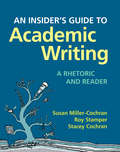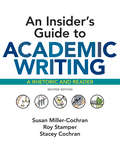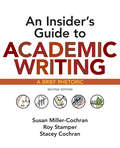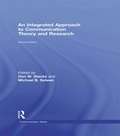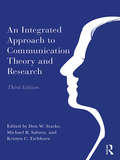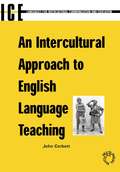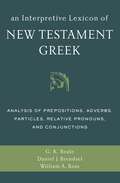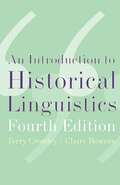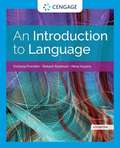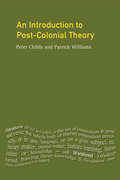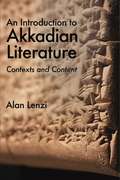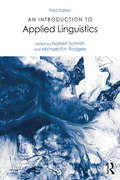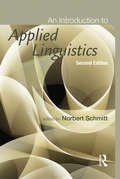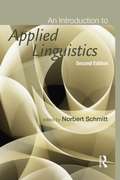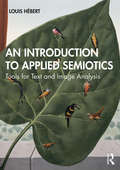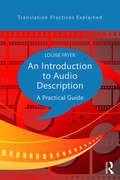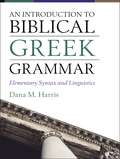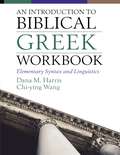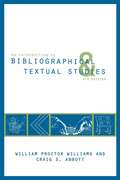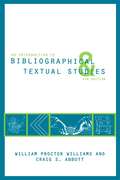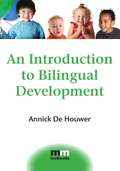- Table View
- List View
An Insider’s Guide to Academic Writing
by Susan Miller-Cochran Roy Stamper Stacey CochranTHIS TITLE HAS BEEN UPDATED TO REFLECT THE 2016 MLA UPDATES! Our editorial team has updated this text based on content from The MLA Handbook, 8th Edition. Browse our catalog or contact your representative for a full listing of updated titles and packages, or to request a custom ISBN. All academic writing requires skills in critical thinking, close reading, argumentation and research, but disciplinary differences among the humanities, social sciences, natural sciences, and applied fields leave students and instructors frustrated by a one-size-fits-all approach to these skills. For writing programs committed to preparing students for the full range of disciplines they will enter, An Insider's Guide to Academic Writing presents a proven pedagogy that helps students to adapt to the academic writing tasks of different disciplinary discourse communities. The pedagogy features a series of flexible, transferable frameworks and concrete connections to the disciplines including unique Insider's video interviews with scholars and peers.
An Insider’s Guide to Academic Writing: A Brief Rhetoric
by Susan Miller-Cochran Roy Stamper Stacey CochranAn Insider’s Guide to Academic Writing: A Brief Rhetoric
An Insider’s Guide to Academic Writing: A Brief Rhetoric
by Susan Miller-Cochran Roy Stamper Stacey CochranAll academic writing requires skills in critical thinking, close reading, argumentation and research, but disciplinary differences among the humanities, social sciences, natural sciences, and applied fields leave students and instructors frustrated by a one-size-fits-all approach to these skills. For writing programs committed to preparing students for the full range of disciplines they will enter, An Insider's Guide to Academic Writing presents a proven pedagogy that helps students to adapt to the academic writing tasks of different disciplinary discourse communities. The pedagogy features a series of flexible, transferable frameworks and concrete connections to the disciplines including unique Insider's video interviews with scholars and peers. Based on the best practices of a first-year composition program that has trained hundreds of teachers who have instructed thousands of students, An Insider's Guide to Academic Writing offers two books in one: an innovative rhetoric of academic writing (available as its own book), and a thematic reader that foregrounds real readings from the disciplines. Use ISBN 978-1-319-05355-0 to get access to the online videos for free with the brief text and ISBN 978-1-319-05354-3 for the version with readings.
An Integrated Approach to Communication Theory and Research (2nd Edition)
by Don W. Stacks Michael B. SalwenThis volume provides an overview of communication study, offering theoretical coverage of the broad scope of communication study as well as integrating theory with research. To explicate the integration process, the chapter contributors -- experts in their respective areas -- offer samples in the form of hypothetical studies, published studies, or unpublished research, showing how theory and research are integrated in their particular fields. The book will appeal to graduate students and faculty members who want a thorough overview of not only the field, but also sample research stemming from its various component parts.
An Integrated Approach to Communication Theory and Research (Routledge Communication Series)
by Don W. Stacks Michael B. Salwen Kristen C. EichhornThis new edition provides a comprehensive overview of current theory and research written by the top theorists and researchers in each area. It has been updated to address the growing influence of technology, changing relationships, and several growing integrated approaches to communication and includes seven new chapters on: ■ Digital Media ■ Media Effects ■ Privacy ■ Dark Side ■ Applied Communication ■ Relational Communication ■ Instructional Communication ■ Communication and the Law The book continues to be essential reading for students and faculty who want a thorough overview of contemporary communication theory and research.
An Intercultural Approach to English Language Teaching
by John CorbettIntercultural language education has redefined the modern languages agenda in Europe and North America. Now intercultural learning is also beginning to impact on English Language Teaching. This accessible book introduces teachers of EFL to intercultural language education by describing its history and theoretical principles, and by giving examples of classroom tasks.
An Interpersonal Pragmatic Study of Professional Identity Construction in Chinese Televised Debating Discourse
by Chengtuan LiThis book explores debaters’ professional identity construction through implicit negation in televised debates from an interpersonal pragmatic perspective. It reveals the linguistic strategies used to indirectly negate the identity of others, and highlights three pairs of professional identity constructed through implicit negation: (1) expert vs. non-expert identity, (2) outsider vs. insider identity, (3) authentic vs. false identity. Furthermore, it proposes the Inter-relationality Principle, self-through-other identity and other-through-self identity, which contribute to Bucholtz and Hall’s theory of identity construction. Lastly, the book discusses the relations between professional identity construction through implicit negation and im/politeness, and builds a model of professional identity construction through implicit negation based on interpersonal pragmatics. By focusing on the interpersonal pragmatics of professional identity construction, the book advances the interpersonal pragmatic study of identity construction, im/politeness and implicit negation. As such, it is a valuable resource for a broad readership, including graduate students, and scholars who are interested in professional identity construction, implicit negation and im/politeness research.
An Interpretive Lexicon of New Testament Greek: Analysis of Prepositions, Adverbs, Particles, Relative Pronouns, and Conjunctions
by Daniel Joseph Brendsel Gregory K. Beale William A. RossThis Interpretive Lexicon has two primary functions aimed at facilitating the exegetical and translational task, namely as a lexicon and also as an interpretive handbook. First, this book lists the vast majority of Greek prepositions, adverbs, particles, relative pronouns, conjunctions, and other connecting words that are notorious for being some of the most difficult words to translate. For each word included, page references are given for several major lexical resources where the user can quickly go to examine the nuances and parameters of the word for translation options. This book will save considerable time for students of the Greek New Testament text. For example, for the Greek preposition en (occurs 2,750 times in the New Testament) covers four pages of small print in the Bauer-Danker lexicon (BDAG). But Interpretive Lexicon digests those pages in just a few lines, with the page numbers and section references given for A Greek-English Lexicon of the New Testament and Other Early Christian Literature, 3rd Edition (BDAG, ’00) and 2nd Edition (BAGD, ’79), Greek Grammar Beyond the Basics (Daniel B. Wallace), and Prepositions and Theology in the Greek New Testament (Murray J. Harris). Thus, the translation options can be analyzed quickly. For words with a lower frequency of occurrence and fewer translation options, this book may be sufficient in itself as a lexicon. Secondly, these prepositions, conjunctions, adverbs, and connecting words in Greek, as in every language, function as explicit discourse-level markers that are essential for ascertaining the main point(s) of a passage. Therefore, this Interpretive Lexicon also evaluates the discourse function(s) of each word that is defined and catalogued, and categorizes its semantic range into defined logical relationships. This feature of the lexicon adds an interpretive element, since translation must include interpretation, at least on a linguistic level. For example, en may be translated in many ways, but those ways are categorized broadly in this book into relationships such as locative (in, among, on), means-end (with, by), grounds (because, on account of), temporal (while, at), and so on. This interpretive feature of the book is tremendously helpful for the exegetical process, allowing for the translator to closely follow the logical flow of the text with greater efficiency. This Interpretive Lexicon is thus a remarkable resource for student, pastor, and scholar alike.
An Introduction To Braille Mathematics: Based On The Nemeth Braille Code For Mathematics And Science Notation, 1972
by Library Of Congress Helen Roberts Bernard Marvin Krebs Barbara Taffet Abraham Nemeth National Library Service for the Blind and Physically Handicapped Staff<P><P><i>Advisory: Bookshare has learned that this book offers only partial accessibility. We have kept it in the collection because it is useful for some of our members. Benetech is actively working on projects to improve accessibility issues such as thesse.</i>
An Introduction To Historical Linguistics
by Terry Crowley Claire BowernAll languages change, just as other aspects of human society are constantly changing. This book is an introduction to the concepts and techniques of diachronic linguistics, the study of language change over time. It covers all themajor areas of historical linguistics, presenting concepts in a clear and concise way. Examples are given from a wide range of languages, with special emphasis on the languages of Australia and the Pacific. While the needs of undergraduate students of linguistics have been kept firmly in mind, the book will also be of interest to the general reader seeking to understand langauge and language change. For this fourth edition, a number of new sections have been written, including many new problems and several datasets. Existing materials have been supplemented with new sections on grammaticalization, tonogenesis, morphological change, and using statistical methods in language classification.
An Introduction To Language
by Victoria Fromkin Robert Rodman Nina M. HyamsAN INTRODUCTION TO LANGUAGE, 11th Edition, offers an up-to-date look at language studies and linguistics in today's world. This product is fresh and modern, and includes new developments in linguistics and related fields that strengthen its appeal to a wider audience. At the same time, it maintains the acclaimed light, friendly, readable style and the breadth of coverage that have made it a perennial best seller. The authors examine grammatical subjects (e.g., morphology, syntax, semantics, phonetics, phonology), childhood language development and adult secondary language acquisition, and the tremendous leap in knowledge achieved in neurolinguistics.
An Introduction To Post-Colonial Theory
by Patrick Williams Peter ChildsThe first book of its kind in the field, this timely introduction to post- colonial theory offers lucid and accessible summaries of the major work of key theorists such as Frantz Fanon, Edward Said.Homi Bhabha and Gayatri Spivak. The Guide also Explores the lines of resistance against colonialism and highlights the theories of post-colonial identity that have been responsible for generating some of the most influential and challenging critical work of recent decades. Designed for undergraduates and postgraduates taking courses related to colonialisn or post-colonialism, the book summarieses the major topics and issues as well as covering the contributions of major and less familiar figures in the field.
An Introduction To The Study Of Literature
by William Henry HudsonThe aim of this book is to set forth, in the simplest possible way, some of the questions to be considered and the principles to be kept in view in the systematic study of literature.
An Introduction to Akkadian Literature: Contexts and Content
by Alan Charles LenziThis book initiates the reader into the study of Akkadian literature from ancient Babylonia and Assyria. With this one relatively short volume, the novice reader will develop the literary competence necessary to read and interpret Akkadian texts in translation and will gain a broad familiarity with the major genres and compositions in the language.The first part of the book presents introductory discussions of major critical issues, organized under four key rubrics: tablets, scribes, compositions, and audiences. Here, the reader will find descriptions of the tablets used as writing material; the training scribes received and the institutional contexts in which they worked; the general characteristics of Akkadian compositions, with an emphasis on poetic and literary features; and the various audiences or users of Akkadian texts. The second part surveys the corpus of Akkadian literature defined inclusively, canvasing a wide spectrum of compositions. Legal codes, historical inscriptions, divinatory compendia, and religious texts have a place in the survey alongside narrative poems, such as the Epic of Gilgamesh, Enuma elish, and Babylonian Theodicy. Extensive footnotes and a generous bibliography guide readers who wish to continue their study.Essential for students of Assyriology, An Introduction to Akkadian Literature will also prove useful to biblical scholars, classicists, Egyptologists, ancient historians, and literary comparativists.
An Introduction to Akkadian Literature: Contexts and Content
by Alan LenziThis book initiates the reader into the study of Akkadian literature from ancient Babylonia and Assyria. With this one relatively short volume, the novice reader will develop the literary competence necessary to read and interpret Akkadian texts in translation and will gain a broad familiarity with the major genres and compositions in the language.The first part of the book presents introductory discussions of major critical issues, organized under four key rubrics: tablets, scribes, compositions, and audiences. Here, the reader will find descriptions of the tablets used as writing material; the training scribes received and the institutional contexts in which they worked; the general characteristics of Akkadian compositions, with an emphasis on poetic and literary features; and the various audiences or users of Akkadian texts. The second part surveys the corpus of Akkadian literature defined inclusively, canvasing a wide spectrum of compositions. Legal codes, historical inscriptions, divinatory compendia, and religious texts have a place in the survey alongside narrative poems, such as the Epic of Gilgamesh, Enuma elish, and Babylonian Theodicy. Extensive footnotes and a generous bibliography guide readers who wish to continue their study.Essential for students of Assyriology, An Introduction to Akkadian Literature will also prove useful to biblical scholars, classicists, Egyptologists, ancient historians, and literary comparativists.
An Introduction to Applied Linguistics
by Norbert Schmitt Michael RodgersAn Introduction to Applied Linguistics provides a complete, authoritative and up-to-date overview of the state of the field. Divided into three sections covering: a description of language and language use; essential areas of enquiry; and language skills and assessment, the third edition of this highly successful textbook provides: • an introductory chapter which familiarises readers with key issues and recurrent themes; • 17 chapters offering extended surveys of central elements of applied linguistics; • two brand-new chapters on multilingualism and forensic linguistics; • re-written chapters on psycholinguistics, language learners, reading and assessment; • hands-on activities and further reading sections for each chapter, encouraging practical analysis and wider reading; • revised and updated references for every chapter. Co-edited by two leading international specialists, with its accessible style, broad coverage and practical focus, this book is ideal for students of applied linguistics, TESOL, and second language pedagogy, as well as practicing teachers and researchers wishing to update their knowledge.
An Introduction to Applied Linguistics
by Norbert SchmittAn Introduction to Applied Linguistics, Second Edition provides a complete, authoritative and up-to-date overview of the state of the field. Each of the 15 chapters offers an extended survey of a central element of Applied Linguistics and is co-authored by two leading international specialists, thus ensuring a full and balanced treatment of the topic covered. The book is divided into three sections: a description of language and language use; essential areas of enquiry; and the four skills and testing. An Introductory chapter familiarises readers with key issues and recurrent themes whilst hands-on activities and further reading sections for each chapter encourage practical analysis and wider reading. For this new edition, each chapter has been fully revised in line with new research and thinking in Applied Linguistics. With its accessible style, broad coverage and practical focus, this book is ideal for students of applied linguistics, TESOL, and second language pedagogy as well as practicing teachers and researchers wishing to update their knowledge.
An Introduction to Applied Linguistics (Second Edition)
by Norbert SchmittAn Introduction to Applied Linguistics, Second Edition provides a complete, authoritative and up-to-date overview of the state of the field. Each of the 15 chapters offers an extended survey of a central element of Applied Linguistics and is co-authored by two leading international specialists, thus ensuring a full and balanced treatment of the topic covered. The book is divided into three sections: a description of language and language use; essential areas of enquiry; and the four skills and testing. An Introductory chapter familiarises readers with key issues and recurrent themes whilst hands-on activities and further reading sections for each chapter encourage practical analysis and wider reading. For this new edition, each chapter has been fully revised in line with new research and thinking in Applied Linguistics. With its accessible style, broad coverage and practical focus, this book is ideal for students of applied linguistics, TESOL, and second language pedagogy as well as practicing teachers and researchers wishing to update their knowledge.
An Introduction to Applied Semiotics: Tools for Text and Image Analysis
by Louis HébertAn Introduction to Applied Semiotics presents nineteen semiotics tools for text and image analysis. Covering a variety of different schools and approaches, together with the author’s own original approach, this is a full and synthetic introduction to semiotics. This book presents general tools that can be used with any semiotic product. Drawing on the work of Fontanille, Genette, Greimas, Hébert, Jakobson, Peirce, Rastier and Zilberberg, the tools deal with the analysis of themes and action, true and false, positive and negative, rhythm narration and other elements. The application of each tool is illustrated with analyses of a wide range of texts and images, from well-known or distinctive literary texts, philosophical or religious texts or images, paintings, advertising and everyday signs and symbols. Each chapter has the same structure – summary, theory and application – and includes exercises and discussion questions, making it ideal for course use. Covering both visual and textual objects, this is a key text for all courses in semiotics and textual analysis within linguistics, communication studies, literary theory, design, marketing and related areas.
An Introduction to Audio Description: A practical guide (Translation Practices Explained)
by Louise FryerAn Introduction to Audio Description is the first comprehensive, user-friendly student guide to the theory and practice of audio description, or media narration, providing readers with the skills needed for the effective translation of images into words for the blind and partially-sighted. A wide range of examples – from film to multimedia events and touch tours in theatre, along with comments throughout from audio description users, serve to illustrate the following key themes: the history of audio description the audience the legal background how to write, prepare and deliver a script. Covering the key genres of audio description and supplemented with exercises and discussion points throughout, this is the essential textbook for all students and translators involved in the practice of audio description. Accompanying film clips are also available at: https://www.routledge.com/products/9781138848177 and on the Routledge Translation Studies Portal: http://cw.routledge.com/textbooks/translationstudies/.
An Introduction to Biblical Greek Grammar: Elementary Syntax and Linguistics
by Dana M. HarrisAn Introduction to Biblical Greek Grammar focuses on the linguistic and syntactic elements of Koine Greek to equip learners for accurate interpretation. Drawing upon twenty years of Greek teaching experience and the latest developments in linguistics and syntax, Harris introduces students to basic linguistic concepts and categories necessary for grasping Greek in ways that are clear and intuitive. This solid foundation enables students first to internalize key concepts, then to apply and build upon them as more complex ideas are introduced.Several features are specifically designed to aid student's learning:Key concepts are graphically coded to offer visual reinforcement of explanations and to facilitate learning forms and identifying their functionsKey concepts are followed by numerous examples from the Greek New TestamentStudents learn how to mark Greek texts so that they can begin to "see" the syntax, identify the boundaries of syntactic units, and construct syntactic outlines as part of their preaching or teaching preparationFour integrative chapters, roughly corresponding to the midterms and final exams of a two-semester sequence, summarize material to date and reinforce key concepts. Here students are also introduced to exegetical and interpretive concepts and practices that they will need for subsequent Greek studies and beyond."Going Deeper" and "For the Curious" offer supplemental information for students interested in learning more or in moving to advanced language study.The accompanying workbook and video lectures (both sold separately) reinforce key concepts through additional contact with the material from each chapter of the grammar. All exercises in the workbook are taken from the Greek New Testament and the Septuagint and include extensive syntactical and exegetical notes to aid students.
An Introduction to Biblical Greek Workbook: Elementary Syntax and Linguistics
by Dana M. Harris Chi-ying WongThis workbook is designed to accompany An Introduction to Biblical Greek Grammar, which focuses on the linguistic and syntactic elements of Koine Greek to equip learners for accurate interpretation. It reinforces key concepts student learn through parsing and translation exercises for each chapter. All texts are taken from the Greek New Testament and the Septuagint and include extensive syntactical and exegetical notes to aid students.In An Introduction to Biblical Greek Grammar, author Dana Harris draws upon twenty years of Greek teaching experience and the latest developments in linguistics and syntax to introduce students to basic linguistic concepts and categories necessary for grasping Greek in ways that are clear and intuitive. This solid foundation enables students first to internalize key concepts, then to apply and build upon them as more complex ideas are introduced.Several features are specifically designed to aid student's learning:Key concepts are graphically coded to offer visual reinforcement of explanations and to facilitate learning forms and identifying their functionsKey concepts are followed by numerous examples from the Greek New TestamentStudents learn how to mark Greek texts so that they can begin to "see" the syntax, identify the boundaries of syntactic units, and construct syntactic outlines as part of their preaching or teaching preparationFour integrative chapters, roughly corresponding to the midterms and final exams of a two-semester sequence, summarize material to date and reinforce key concepts. Here students are also introduced to exegetical and interpretive concepts and practices that they will need for subsequent Greek studies and beyond."Going Deeper" and "For the Curious" offer supplemental information for students interested in learning more or in moving to advanced language study.
An Introduction to Bibliographical and Textual Studies
by William Proctor Williams Craig S. AbbottTo a reader of Joyce's Ulysses, it makes a difference whether one of Stephen Dedalus's first thoughts is "No mother" (as in the printed version) or "No, mother!" (as in the manuscript). The scholarship surrounding such textual differences--and why this discipline should concern readers and literary scholars alike--is the focus of William Proctor Williams and Craig S. Abbott's acclaimed handbook.This updated, fourth edition outlines the study of texts' composition, revision, physical embodiments, process of transmission, and manner of reception; describes how new technologies such as digital imaging and electronic tagging have changed the way we produce, read, preserve, and research texts; discusses why these matters are central to a historical understanding of literature; and shows how the insights, methods, and products of bibliographical and textual studies can be applied to other branches of scholarship.
An Introduction to Bibliographical and Textual Studies (Fourth Edition)
by William Proctor Williams Craig S. Abbott<p>To a reader of Joyce's Ulysses, it makes a difference whether one of Stephen Dedalus's first thoughts is "No mother" (as in the printed version) or "No, mother!" (as in the manuscript). The scholarship surrounding such textual differences--and why this discipline should concern readers and literary scholars alike--is the focus of William Proctor Williams and Craig S. Abbott's acclaimed handbook. <p>This updated, fourth edition outlines the study of texts' composition, revision, physical embodiments, process of transmission, and manner of reception; describes how new technologies such as digital imaging and electronic tagging have changed the way we produce, read, preserve, and research texts; discusses why these matters are central to a historical understanding of literature; and shows how the insights, methods, and products of bibliographical and textual studies can be applied to other branches of scholarship.</p>
An Introduction to Bilingual Development
by Annick De HouwerIncreasingly, children grow up hearing two languages from birth. This introductory textbook shows how children learn to understand and speak those languages against the backdrop of their language learning environments. A narrative around the bilingual development of four young children with different language profiles helps to explain the latest research findings in a lively and accessible manner. The narrative describes how bilingually raised children learn to understand and use sounds, words and sentences in two languages, and how they are able to use each of their languages in socially appropriate ways. Positive attitudes towards bilingual development from the people in bilingual children's environments and their recognition that child bilingualism is not monolingualism-times-two are the main ingredients ensuring that children grow up to be happy and expert speakers of two languages.
